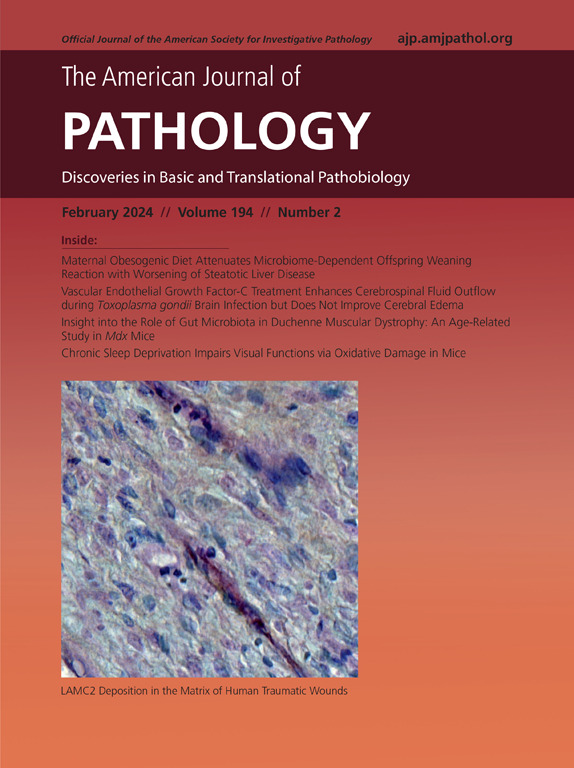Ferredoxin 2 Is Critical for Tumor Suppression and Lipid Homeostasis but Dispensable for Embryonic Development
IF 3.6
2区 医学
Q1 PATHOLOGY
引用次数: 0
Abstract
Ferredoxin 1 and 2 (FDX1/2) constitute an evolutionarily conserved FDX family of iron-sulfur cluster–containing proteins. FDX1/2 are cognate substrates of ferredoxin reductase and serve as conduits for electron transfer from NADPH to a set of proteins involved in biogenesis of corticosteroids, hemes, iron-sulfur cluster, and lipoylated proteins. Fdx1 is essential for embryonic development and lipid homeostasis. Herein, Fdx2-deficient mice were generated to explore the physiological role of FDX2. Interestingly, unlike Fdx1-null embryos, which were dead at embryonic day 10.5 to 13.5, Fdx2-null mice were viable. Both Fdx2-null and Fdx2-heterozygous mice had a short lifespan and were susceptible to spontaneous tumors and steatohepatitis. Moreover, FDX2 deficiency increased, whereas overexpression of FDX2 decreased cytoplasmic accumulation of lipid droplets. Consistently, FDX2 deficiency led to accumulation of cholesterol and triglycerides. Mechanistically, FDX2 deficiency suppressed expression of cholesterol transporter ATP-binding cassette transporter A1 (ABCA1) and activated master lipid transcription regulators sterol regulatory element-binding proteins 1/2, thus leading to altered lipid metabolism. Untargeted lipidomic analysis showed that FDX2 deficiency led to altered biosynthesis of various lipid classes, including cardiolipins, cholesterol, ceramides, triglycerides, and fatty acids. In summary, these findings underline an indispensable role of FDX2 in tumor suppression and lipid homeostasis at both cellular and organismal levels without being a prerequisite for embryonic development.
铁氧还蛋白2对肿瘤抑制和脂质稳态至关重要,但在胚胎发育中是必不可少的。
铁氧还蛋白1和2 (FDX1/2)构成了一个进化保守的含铁硫簇(ISC)蛋白FDX家族。FDX1/2是铁氧还蛋白还原酶(FDXR)的同源底物,并作为电子从NADPH转移到一系列参与类固醇、血红素、ISC和脂化蛋白生物发生的蛋白质的通道。最近,我们发现Fdx1对胚胎发育和脂质稳态至关重要。为了探索FDX2的生理作用,我们制造了FDX2缺陷小鼠。有趣的是,我们发现不像fdx1缺失的胚胎在胚胎期10.5至13.5天死亡,fdx2缺失的小鼠是有活力的。我们还发现,fdx2缺失和fdx2杂合小鼠的寿命都很短,并且容易发生自发性肿瘤和脂肪性肝炎。此外,我们发现FDX2缺乏增加,而FDX2过表达减少了细胞质脂滴的积累。我们一致发现,FDX2缺乏会导致胆固醇和甘油三酯的积累。在机制上,我们发现FDX2缺乏抑制胆固醇转运蛋白ABCA1的表达,激活主要脂质转录调控因子SREBP1/2,从而导致脂质代谢改变。非靶向脂质组学分析显示,FDX2缺乏导致多种脂类生物合成的改变,包括心磷脂、胆固醇、神经酰胺、甘油三酯和脂肪酸。总之,我们的研究结果强调了FDX2在细胞和组织水平上对肿瘤抑制和脂质稳态的不可或缺的作用,而不是胚胎发育的先决条件。
本文章由计算机程序翻译,如有差异,请以英文原文为准。
求助全文
约1分钟内获得全文
求助全文
来源期刊
CiteScore
11.40
自引率
0.00%
发文量
178
审稿时长
30 days
期刊介绍:
The American Journal of Pathology, official journal of the American Society for Investigative Pathology, published by Elsevier, Inc., seeks high-quality original research reports, reviews, and commentaries related to the molecular and cellular basis of disease. The editors will consider basic, translational, and clinical investigations that directly address mechanisms of pathogenesis or provide a foundation for future mechanistic inquiries. Examples of such foundational investigations include data mining, identification of biomarkers, molecular pathology, and discovery research. Foundational studies that incorporate deep learning and artificial intelligence are also welcome. High priority is given to studies of human disease and relevant experimental models using molecular, cellular, and organismal approaches.

 求助内容:
求助内容: 应助结果提醒方式:
应助结果提醒方式:


